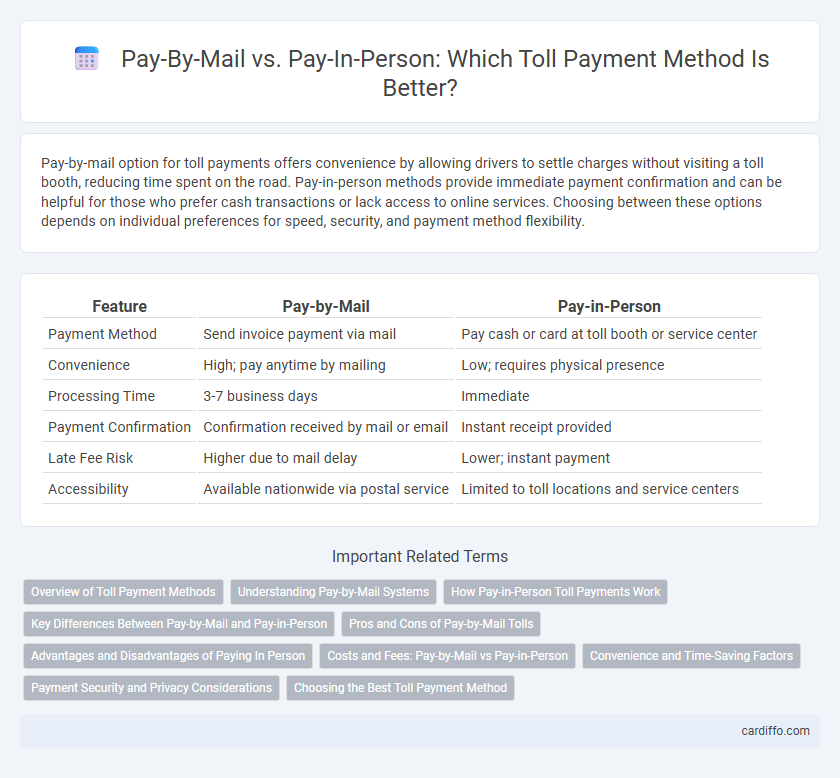Pay-by-mail option for toll payments offers convenience by allowing drivers to settle charges without visiting a toll booth, reducing time spent on the road. Pay-in-person methods provide immediate payment confirmation and can be helpful for those who prefer cash transactions or lack access to online services. Choosing between these options depends on individual preferences for speed, security, and payment method flexibility.
Table of Comparison
| Feature | Pay-by-Mail | Pay-in-Person |
|---|---|---|
| Payment Method | Send invoice payment via mail | Pay cash or card at toll booth or service center |
| Convenience | High; pay anytime by mailing | Low; requires physical presence |
| Processing Time | 3-7 business days | Immediate |
| Payment Confirmation | Confirmation received by mail or email | Instant receipt provided |
| Late Fee Risk | Higher due to mail delay | Lower; instant payment |
| Accessibility | Available nationwide via postal service | Limited to toll locations and service centers |
Overview of Toll Payment Methods
Toll payment methods include pay-by-mail and pay-in-person options, each offering distinct convenience and processing times. Pay-by-mail requires drivers to receive and settle invoices sent after toll passage, often preferred for those without electronic transponders but may result in delayed payments or penalties. Pay-in-person enables immediate settlement at authorized locations such as toll booths or service centers, facilitating instant confirmation and avoiding potential late fees.
Understanding Pay-by-Mail Systems
Pay-by-mail systems for toll payments allow drivers to receive a bill after using toll roads, eliminating the need for electronic transponders or immediate payment at toll booths. These systems rely on license plate recognition technology to identify vehicles and send invoices based on recorded toll crossings. Understanding how pay-by-mail works can help users avoid fines by ensuring timely payment and accurate address registration.
How Pay-in-Person Toll Payments Work
Pay-in-person toll payments involve physically visiting a toll facility or authorized payment center to settle toll charges using cash, debit, or credit cards. Toll agencies record the transaction on-site, immediately updating the vehicle's account or issuing a receipt to the driver. This method ensures direct payment and is preferred by drivers without electronic toll tags or those avoiding post-paid billing systems like pay-by-mail.
Key Differences Between Pay-by-Mail and Pay-in-Person
Pay-by-mail requires sending payment through postal services, often involving slips or notices, whereas pay-in-person allows immediate payment at toll booths or authorized locations. Pay-by-mail may incur additional processing time and potential late fees if mail is delayed, while pay-in-person ensures instant transaction confirmation. Both methods offer convenience, but pay-in-person is preferred for immediate clearance, and pay-by-mail suits users without direct access to payment centers.
Pros and Cons of Pay-by-Mail Tolls
Pay-by-mail tolls offer convenience by eliminating the need for immediate payment, allowing drivers to receive invoices at their address, which can reduce delays and traffic congestion at toll plazas. However, this method may incur higher administrative fees, increase the risk of missed payments, and cause delays in receiving bills, potentially leading to late penalties. The system requires accurate vehicle registration and address information to ensure proper billing and avoid disputes.
Advantages and Disadvantages of Paying In Person
Paying tolls in person offers immediate transaction confirmation and the ability to resolve disputes directly with an attendant, ensuring accuracy and peace of mind. However, this method often requires waiting in lines, which can delay travel and increase fuel consumption. The lack of electronic record-keeping compared to pay-by-mail systems may also complicate expense tracking and reimbursement.
Costs and Fees: Pay-by-Mail vs Pay-in-Person
Pay-by-mail toll payments often incur higher processing fees compared to pay-in-person transactions, which typically avoid extra charges. Pay-in-person payments can provide immediate confirmation and avoid late fees common with mail delays. Evaluating the total cost, including service fees and potential penalties, helps determine the most economical payment method.
Convenience and Time-Saving Factors
Pay-by-mail offers significant convenience by eliminating the need to visit toll booths, allowing drivers to settle tolls from home or office without disrupting their schedules. This method reduces wait times and prevents traffic congestion, saving valuable time during daily commutes. In contrast, pay-in-person requires physical presence, which can lead to longer queues and increased travel time, making pay-by-mail a more efficient option for time-conscious travelers.
Payment Security and Privacy Considerations
Pay-by-mail toll payments involve mailing a check or money order, which can expose personal financial information to risks like loss or theft during transit. Pay-in-person payments, made at toll booths or customer service centers, offer more immediate transaction security through direct interaction and often provide receipt confirmation for privacy assurance. Choosing pay-in-person methods reduces the potential for identity theft and ensures payment information remains confidential and less vulnerable to fraud.
Choosing the Best Toll Payment Method
Choosing the best toll payment method depends on convenience and cost-effectiveness, with pay-by-mail offering flexibility for infrequent users but often incurring higher fees and delayed processing. Pay-in-person payments guarantee immediate clearance of tolls, reducing the risk of penalties, but require physical visits to payment locations. Evaluating travel frequency, fee structures, and payment timelines helps determine the optimal toll payment option.
Pay-by-mail vs pay-in-person Infographic

 cardiffo.com
cardiffo.com